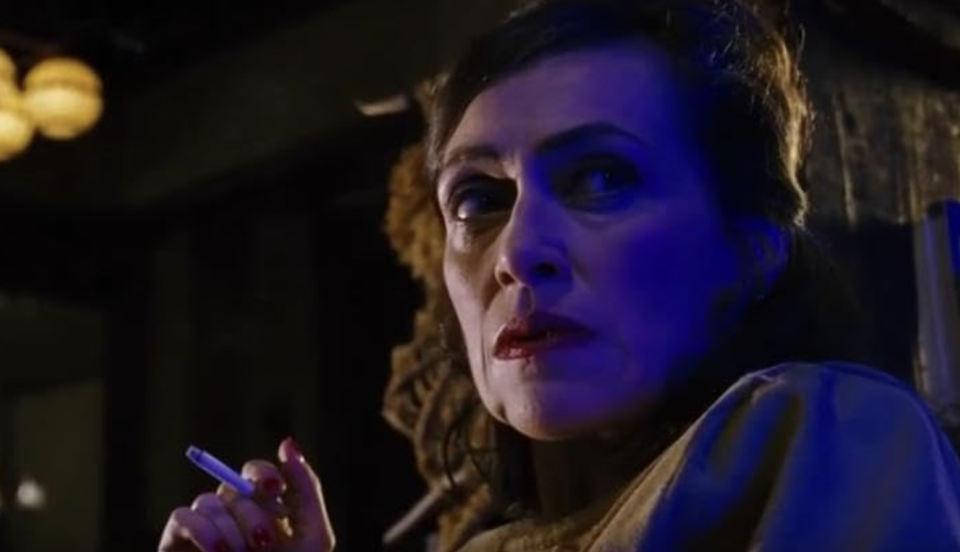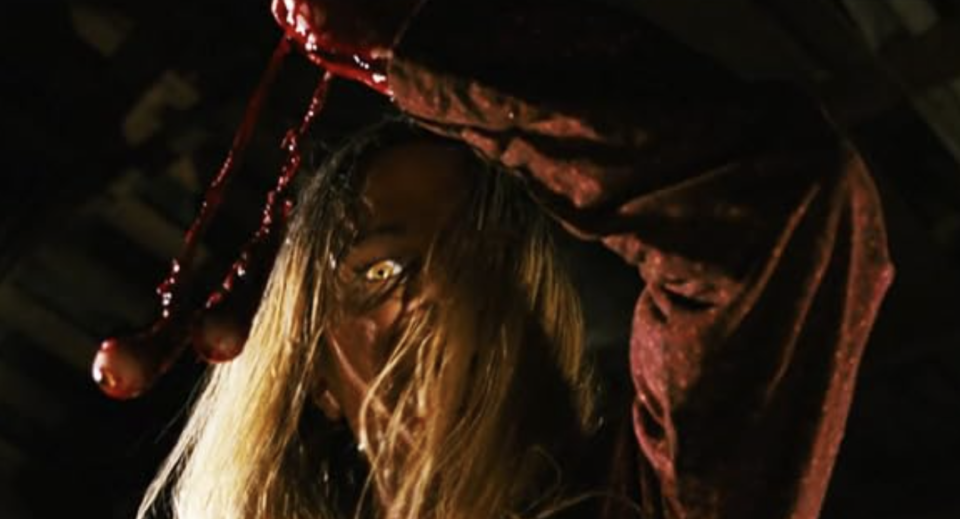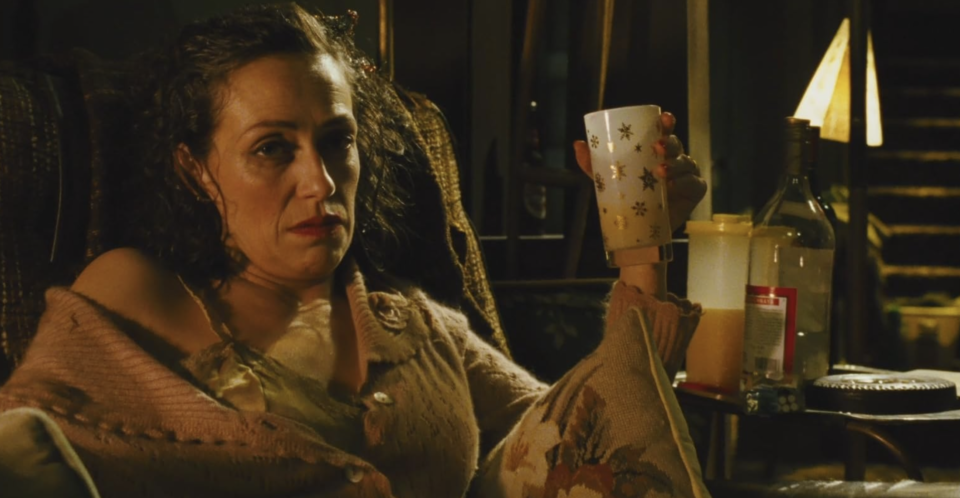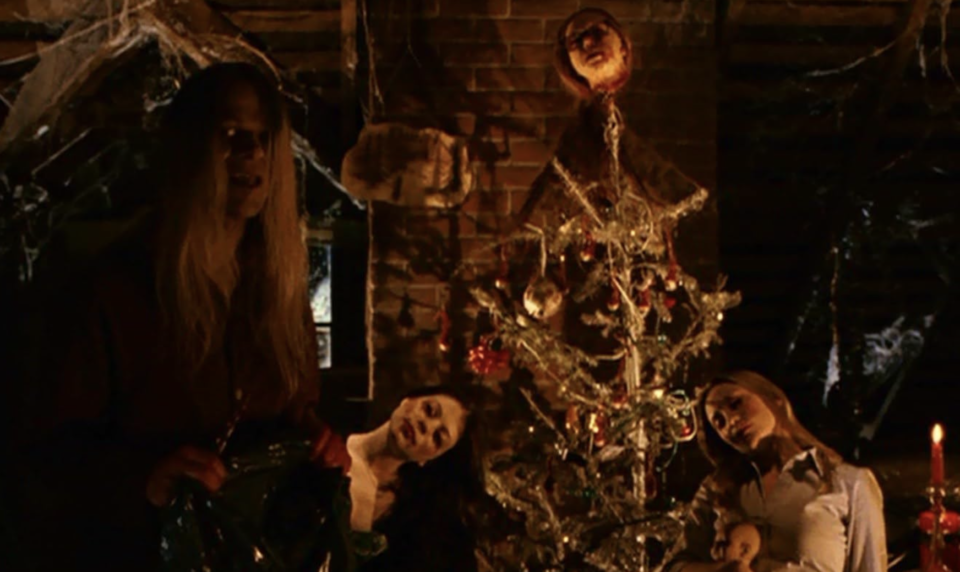‘Black Christmas’ (2006) Takes the Knife Out of Billy’s Hands [Fatal Femmes]

Black Christmas (1974) is one of those rare movies that seems too good to be true. Bob Clark’s horrific holiday classic is filled with seasonal ambiance, likable characters, well-calibrated humor, and the laudable restraint to keep the killer almost completely hidden for the duration of the film. Arguably the origin of the final girl archetype and the inspiration for Halloween, this near-perfect film is widely regarded as one of the best the genre has to offer.
The same cannot be said for its 2006 remake. Though Glen Morgan’s Black Christmas has its ardent defenders, there’s no question that it pales in comparison to the original. His variation is filled to the brim with the garish gore and spiteful humor popular in mid-aughts horror. The sorority sisters are vicious, the pants ride low, and the grimy effects have an upsetting more-is-more quality that feels directly inspired by the torture porn phenomenon. Love it or hate it, this remake takes seeds from Clark’s Black Christmas and fleshes them out to create not one, but two killers living in the Delta Alpha Kappa sorority house attic. A tragic backstory not only lends sympathy to Billy (Robert Mann) and his sister Agnes (Dean Friss) but blames this deadly Christmas Eve on the actions of a bad mother.
Her Story

As the DAK sisters try to weather a dangerous storm, the legend of Billy Lenz emerges. Born in 1970, baby Billy has a liver condition that causes his skin to appear yellow. Perhaps this is why his mother hates him, or maybe it’s simply because this male child resembles her kind husband whom she also despises. The only interaction we see between mother and baby is this vile woman sprinkling the shards of a crushed ornament into her son’s crib. We never learn why Mrs. Lenz (Karin Konoval) is so spiteful. She appears to be nothing more than a cold and increasingly sloppy woman who shoots drunken barbs at her family while chain-smoking in a dirty armchair. More cartoon than character, she murders Billy’s father on Christmas Eve then locks her son in the attic when he oversees her burying the body with her new lover.
As this hideous backstory unfolds, the lengths of her matronly madness expand. Fed up with her boyfriend’s inability to perform, Mrs. Lenz rapes her twelve-year-old son and subsequently gives birth to a baby girl named Agnes. Adding insult to injury, she looks up at Billy’s overhead prison and proclaims that this new baby is her family now, a line Billy will come to embrace. As the years go by, Billy watches from afar as his mother dotes on his sister/daughter while using his telescope to observe the idyllic families living nearby. Dreaming of a wholesome Christmas, he sneaks down from the attic and attacks Agnes (Christina Crivici), stabbing her in the face and then eating her right eye. Billy continues this carnage by slaughtering the rest of the household and using a cookie cutter to bake holiday treats from his mother’s skin.
Confined to a mental institution ever since the murders, we learn that Billy spends every Christmas trying to escape in hopes of returning to his family home. Agnes has grown up in an orphanage, isolated and shunned by visiting parents looking to adopt. It seems that her path has also led her back to the home of her birth and she waits in the attic for the day when her brother/daddy will return. Though Billy makes the iconic phone calls made famous in Clark’s Black Christmas, Agnes proves to be the bigger threat, tearing her way through the DAK sisters to make way for her own family reunion.
Her Weapons

Clark’s Black Christmas opens with an upsetting sequence in which an unseen killer we assume to be Billy suffocates a sorority sister with a dry cleaning bag. Morgan takes this imagery and runs wild, creating a sinister MO that all three killers will employ. As a child, Billy (Cainan Wiebe) watches his mother wrap a plastic bag around his father’s face and then stab him in the eye. Her children follow in these footsteps and use similar plastic bags to incapacitate their victims before impaling them with whatever sharp object happens to be within reach. Agnes seems to have taken a nod from both her parents and adds a bit of decorative flair to each of her kills. Like Billy, she removes the eyes of her victims and hangs them from the branches of her attic tree which also happens to be topped with a severed head.
Though Mrs. Lenz kills her husband with a hammer, the greatest weapon she wields is her cruelty. With no love for anyone but Agnes, she tortures her son with spiteful comments about Russian soldiers shooting Santa out of the sky and seems determined to cause as much pain as she possibly can. The line “she’s my family now” cuts Billy like a knife as she tells him in no uncertain terms that he has been replaced. Not only has he never been the child she wanted, but a daughter—his daughter—has come to succeed where he failed.
Her Motive

We never find out exactly why Mrs. Lenz is so vile. She seems to be little more than a stereotypical Bad Mother with her vicious cruelty turned up to 11. As her evil increases, her physical appearance also deteriorates. In 1970, we see her smoking next to a few bottles of beer, but this visage will continue to decay as the years go by. Surrounded by ever-larger bottles of alcohol and more and more cigarettes, her hair gets messier, her clothing becomes more revealing, and her persona feels more garish. She may love her daughter, but even this attention feels like a threat based on the severity of her sloppy appearance. In the language of the film, her outer ugliness has translated to inner psychopathy and she falls into the cookie-cutter role of female monster.
Agnes’s own appearance changes in a way that casts an ugly light on the film itself. Though female actor Christina Crivici plays the 8-year-old Agnes, Morgan cast Dean Friss, a male actor to play the character as an adult. No mention is ever made of Agnes transitioning and characters consistently use she/her pronouns giving the uncomfortable suggestion that her more masculine appearance parallels Mrs. Lenz’s physical deterioration. A camera operator, Friss had no acting experience when cast in the role and has not pursued the profession since.
Though it’s not uncommon for male-identifying actors to play female characters and vice versa, this choice seems to have been made simply to paint the character as distinctly unfeminine and therefore evil. Young Agnes, when played by a girl, is a sympathetic character, but her adult counterpart is a monstrous killer. With no motive for her crimes, we’re led to believe that her appearance is not only wrong, but has made her unloveable. Her masculine persona has made her an outcast and caused her to kill.
Her Victims

The vile Lenz family stands in sharp contrast to the glamorous sisters of Delta Alpha Kappa. Morgan updates the complex female characters of Clark’s original film through the crass harshness of the era. Though Kelli (Katie Cassidy) is our final girl, the DAK house overflows with a clan of snarky sorority sisters played by beloved actresses of the 90s and early aughts. Though some sisters seem kinder than others, many of them are catty and snide, embodying the stereotype that gives the Greek system a bad name. Andrea Martin returns as the long-suffering house mother—a legacy character from Clark’s original Black Christmas—but even she quickly tires of these entitled young women.
Regardless of how mean these girls are to each other, they are physically beautiful and thus our heroes. Rather than Mrs. Lenz’s beer and liquor, they drink classy red wine. But their catty fireside conversations reveal a deep streak of haughty disdain. As details emerge, we find that each sister comes from a relatively unhappy or empty home. Clair (Leela Savasta) is trying to reconnect with her half-sister after a decades-long feud and Dana (Lacey Chabert) openly jokes about burying a hatchet in her sibling’s head. Though probably less violent than the Lenzs, it’s not out of the question to imagine them sitting around a tree and sniping at each other just like Billy’s mother, the only difference being their socially acceptable appearance.
This may seem like a stretch or unfair condemnation until we consider another legacy sister named Eve (Kathleen Kole). Framed as unnaturally tall, this awkward sister wears thick glasses with understated clothes and hands Heather (Mary Elizabeth Winstead) a gift wrapped in newspaper rather than fancy bows. All of the girls treat her like a pariah, openly questioning how she got into the sorority and making it clear that she doesn’t belong. Ms. Mac tells us that she is a “legacy,” her parentage granting her acceptance that her appearance would otherwise prohibit. Eve is portrayed as a sinister red herring and it’s possible to believe that she may be the killer until her head is seen falling out of her abandoned car.
Her Legacy

While Clark’s original film is a feminist masterpiece that presents a strong argument for reproductive freedom while also showing the inherent dangers of a patriarchal society, Morgan’s Black Christmas is a monument to female ugliness. Billy is indeed a killer, but Mrs. Lenz is the film’s true monster. He was once a helpless baby boy with a mild deformity and a cruel mother. Agnes was a child born from rape and incest, abandoned by the only family she’d ever known. Growing up in unthinkable trauma has caused these siblings to kill just as surely as if their mother were holding the knife. Combined with the casual cruelty of the new generation of DAK sisters, it’s difficult to walk away from Black Christmas (2006) with anything but a negative view of women in general.
Categorized:Editorials

